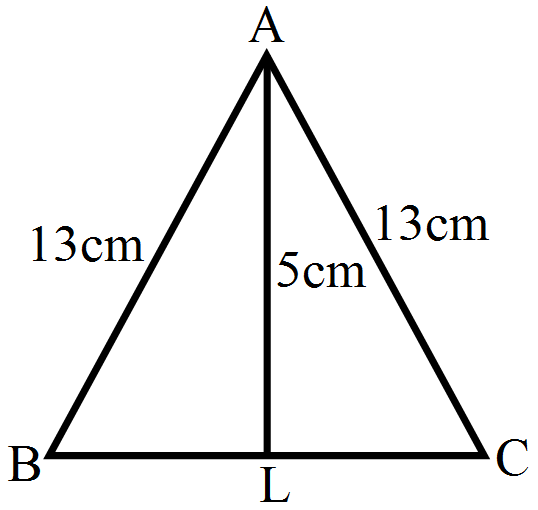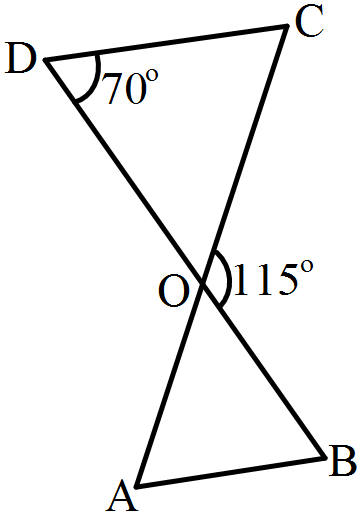$\triangle\text{ABC}$ is an isosceles triangle with $AB = AC = 13\ cm$. The length of altitude from $A$ on $BC$ is $5\ cm$. Find $BC$.
Given: $\triangle\text{ABC}$ is an isosceles triangle with $AB = AC = 13\ cm^2$ Const:
Draw altitude from A to BC $(\text{AL}\perp\text{BC} ).$
Now, $AL = 5\ cm$

In $\triangle\text{ALB},$ $\angle\text{ALB}=90^\circ$
$\therefore\text{AB}^2=\text{AL}^2+\text{BL}^2$(by pythagoras theorem)
$\therefore13^2=(5)^2+\text{BL}^2$ $(169-25)\text{cm}^2=\text{BL}^2$
$\text{BL}^2=144\text{cm}^2$ $\text{BL}=\sqrt{144}\text{cm}=12\text{cm}$ In $\triangle\text{ALC},$
$\angle\text{ALC}=90^\circ$ $\text{AC}^2=\text{AL}^2+\text{LC}^2$
$\Rightarrow\text{LC}^2=\Big(\text{AC}^2-\text{AL}^2\Big)$
$=\Big[(13)^2-(5)^2\Big]\text{cm}^2$ $=(169-25)\text{cm}^2$
$=144\text{cm}^2$
$=\sqrt{144}=12\text{cm}$ $\therefore\text{BC}=\text{BL}+\text{LC}$
$=(12+12)\text{cm}=24\text{cm}$
Draw altitude from A to BC $(\text{AL}\perp\text{BC} ).$
Now, $AL = 5\ cm$

In $\triangle\text{ALB},$ $\angle\text{ALB}=90^\circ$
$\therefore\text{AB}^2=\text{AL}^2+\text{BL}^2$(by pythagoras theorem)
$\therefore13^2=(5)^2+\text{BL}^2$ $(169-25)\text{cm}^2=\text{BL}^2$
$\text{BL}^2=144\text{cm}^2$ $\text{BL}=\sqrt{144}\text{cm}=12\text{cm}$ In $\triangle\text{ALC},$
$\angle\text{ALC}=90^\circ$ $\text{AC}^2=\text{AL}^2+\text{LC}^2$
$\Rightarrow\text{LC}^2=\Big(\text{AC}^2-\text{AL}^2\Big)$
$=\Big[(13)^2-(5)^2\Big]\text{cm}^2$ $=(169-25)\text{cm}^2$
$=144\text{cm}^2$
$=\sqrt{144}=12\text{cm}$ $\therefore\text{BC}=\text{BL}+\text{LC}$
$=(12+12)\text{cm}=24\text{cm}$
Download our appand get started for free
Experience the future of education. Simply download our apps or reach out to us for more information. Let's shape the future of learning together!No signup needed.*
Similar Questions
- 1View SolutionIn the given pairs of triangles, find which pair of triangles are similar. State the similarity criterior and write the similarity relation in symbolic from.

- 2The corresponding sides of two similar triangles are in the ratio $2 : 3.$ If the area of the smaller triangle is $48\ cm^2,$ find the area of the larger triangle.View Solution
- 3View SolutionA 13-m-long ladder reaches a window of a building 12m above the ground. Determine the distance of the foot of the ladder from the building.
- 4In the given figure, $\triangle\text{ODC}\sim\triangle\text{OBA},\angle\text{BOC}=115^\circ$ and $\angle\text{CDO}=70^\circ.$View Solution
Find- $\angle\text{DOC}$
- $\angle\text{DCO}$
- $\angle\text{OAB}$
- $\angle\text{OBA}$

- 5View SolutionState the two properties which are necessary for given two triangles to be similar.
- 6View SolutionFor the following statments state whether true (T) or false(F):
The ratio of the areas of two similar triangles is equal to the ratio of their corresponding angle-bisector segments. - 7View SolutionA vertical pole of lenght 7.5m casts a shadow 5m long on the ground and at the same time a tower casts a shadow 24m long. Find the height of the tower.
- 8In the given figure, side BC of $\triangle\text{ABC}$ is bisected at D and O is any point on AD. BO and CO produced meet AC and AB at E and F respectively, and AD is produced to X so that D is the midpoint of OX Prove that AO : AX = AF : AB and show that EF || BC.View Solution

- 9In $\triangle\text{ABC},$ the bisector of $\angle\text{B}$ meets AC at D. A line PQ || AC meets AB, BC and BD at P, Q and R respectively.View Solution
Show that PR × BQ = QR × BP.

- 10View SolutionFind the lenght of each side of a rhombus whose diagonals are 24cm and 10cm. long.
